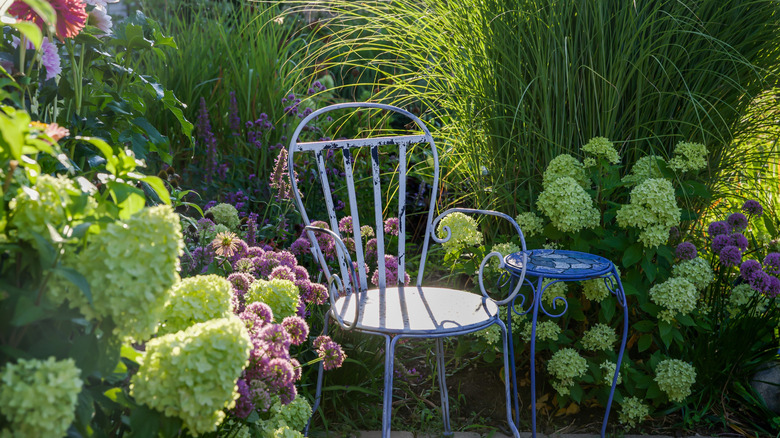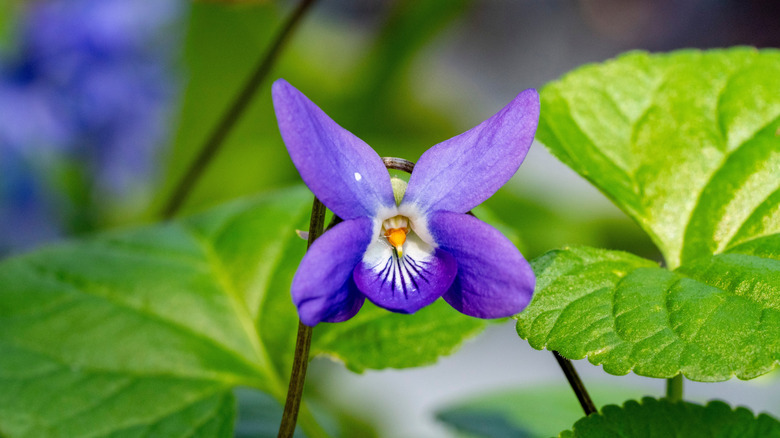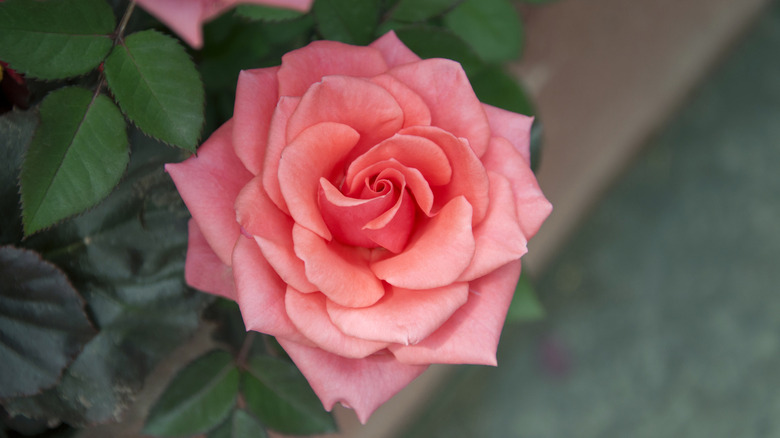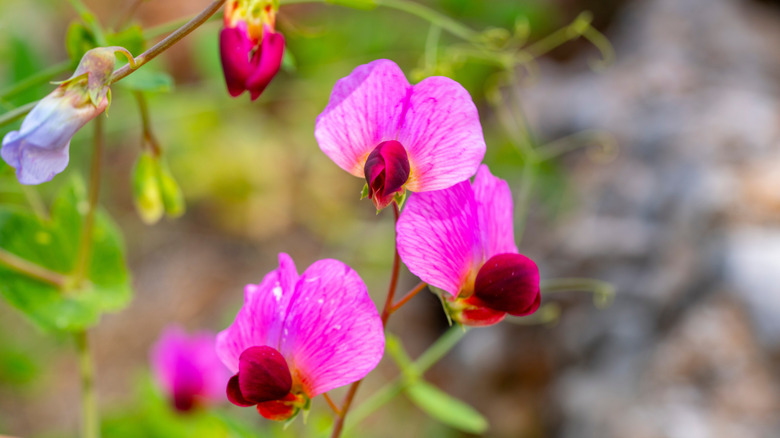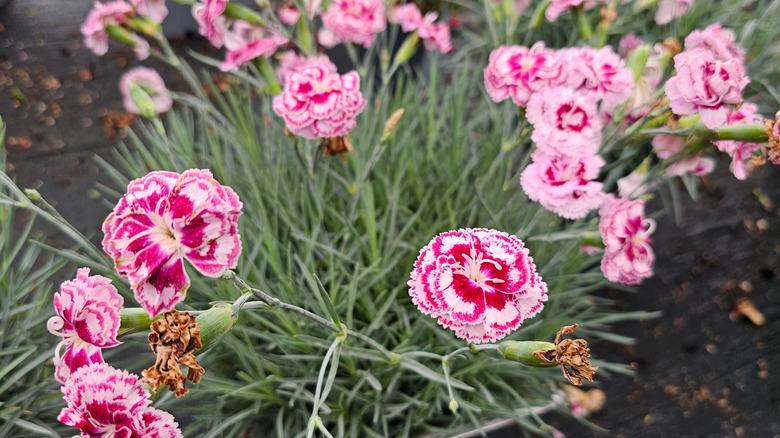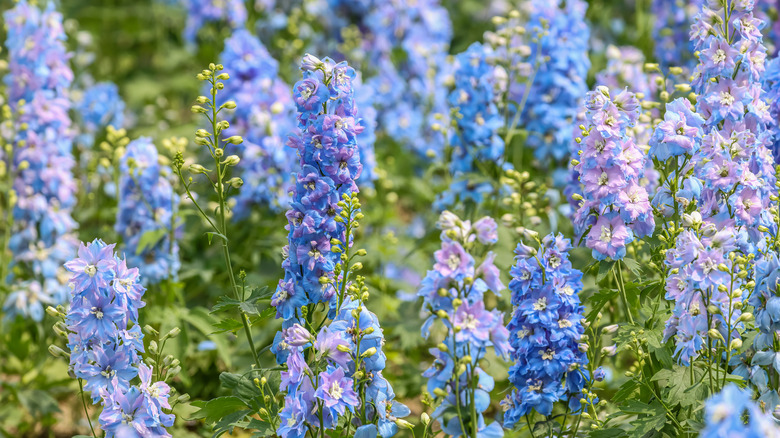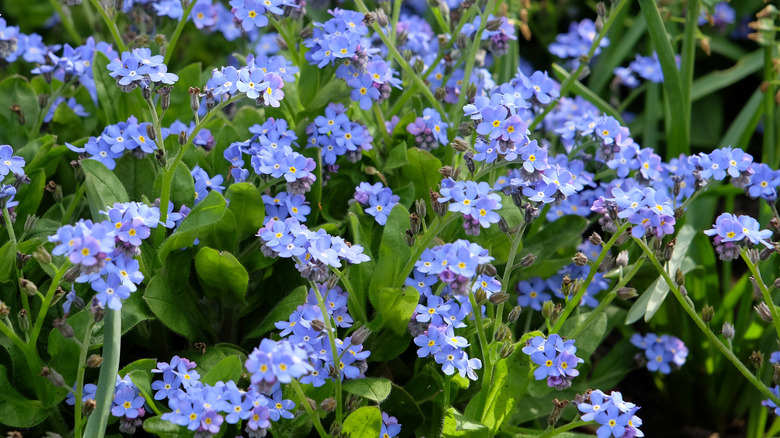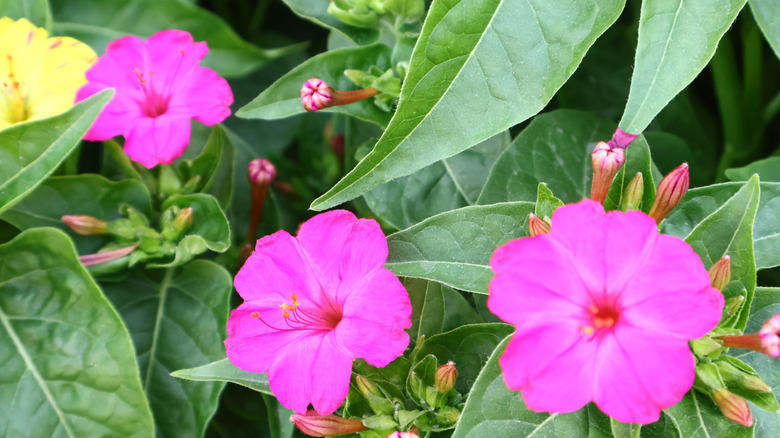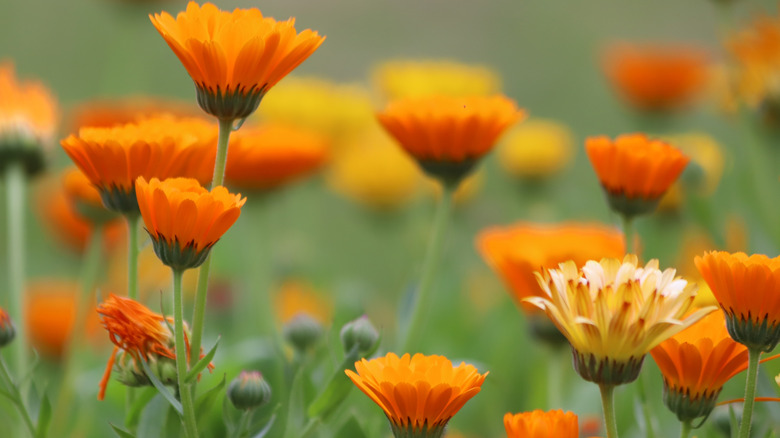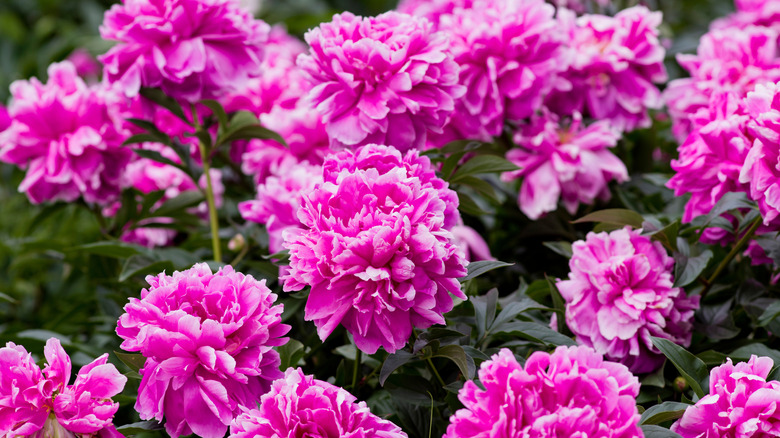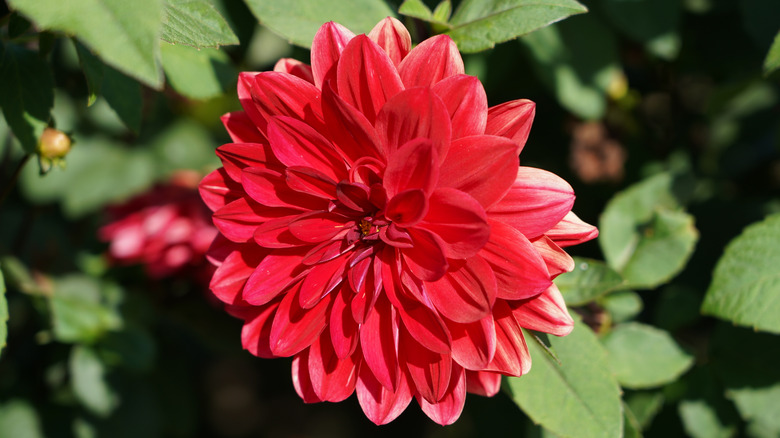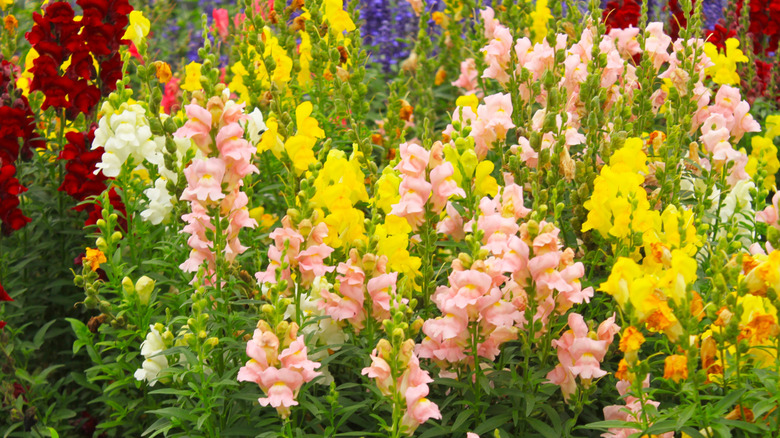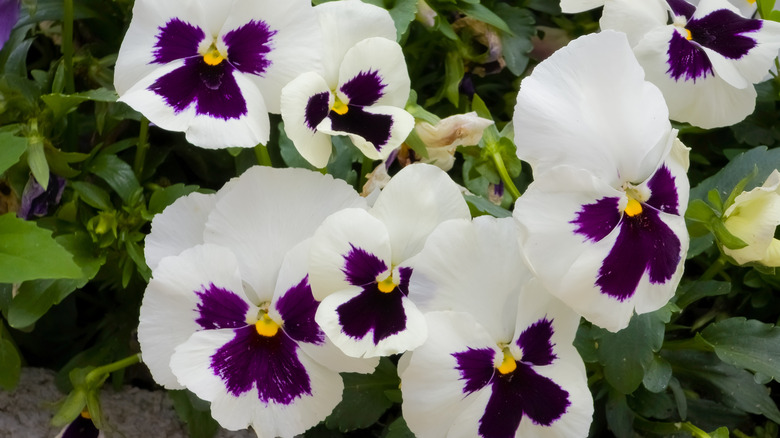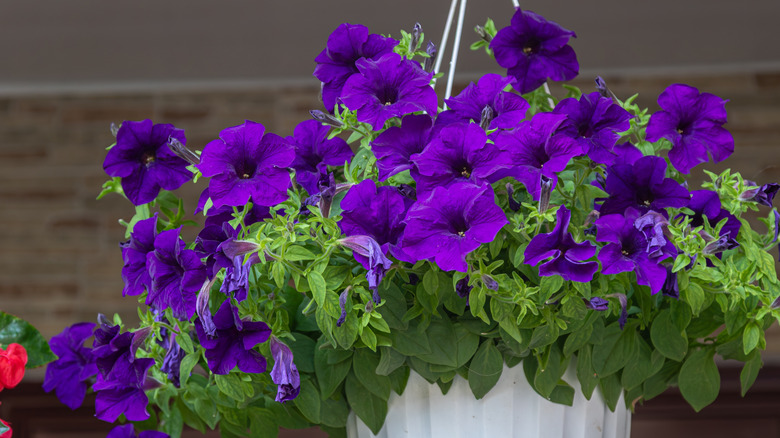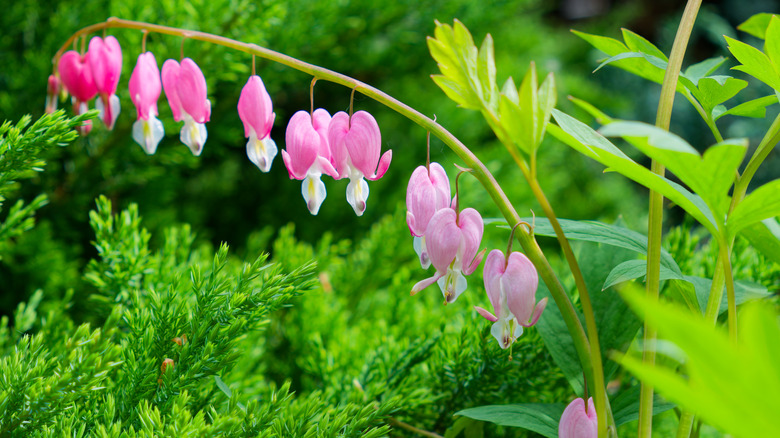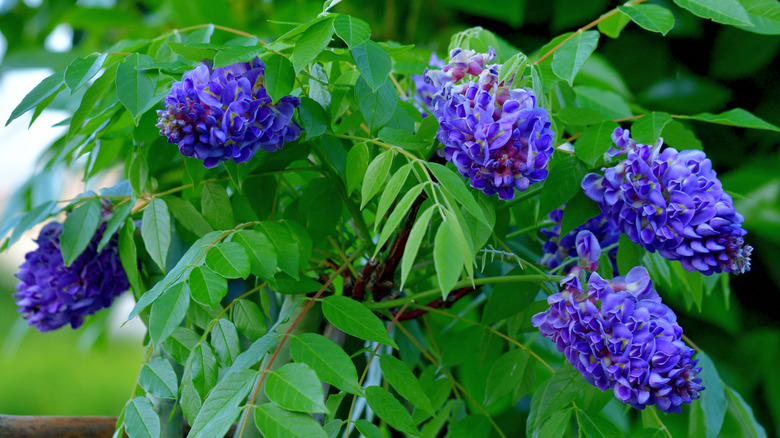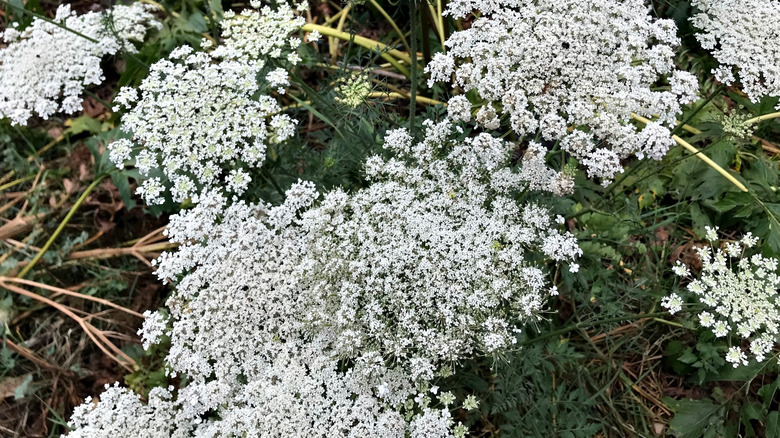26 Vintage Garden Flowers That Never Go Out Of Style
Creating a garden inspired by vintage flowers is easier than it sounds. The word "vintage," borrowed from the worlds of clothing and collectibles, generally refers to items that are at least 20 years old but less than a century in age. A vintage-style garden isn't about recreating the past — it's about remembering times gone by and capturing the appeal of classic blooms that remain in style after several decades (and, in some cases, even hundreds of years). With the right mix of heirloom plants and thoughtful design, you can grow a landscape that feels both historic and deeply personal.
Your vintage-style garden design shouldn't stop at the flowers you choose, though. Adding vintage touches to your garden fits perfectly with the DIY spirit. Gardeners may use reclaimed items, such as old furniture. Some even find and use wheelbarrows or old flower carts, the latter of which are a piece of yard decor you can thrift to give your garden serious vintage vibes. These reclaimed pieces not only highlight the flowers but also tell a story of creativity and reuse.
The romanticism that vintage flowers symbolize runs deep. Many vintage plants were popularized during the Victorian era, when flowers grew to have distinct meanings that allowed individuals to convey difficult feelings. Growing these same varieties today connects gardeners to that living history — a reminder that beauty and meaning can thrive together in every season.
Violet
Sweet violets (Viola odorata) are a wonderful choice for any vintage-style garden, enjoyed for their low maintenance and attractive flowers. Their aromatic, blue-violet or white flowers rise a little above heart-shaped foliage, creating clusters that spread gently through rhizomes and stolons without becoming invasive. Native to Europe and western Asia, this perennial is one of the best purple plants for your flower garden. It flourishes in partial shade and moist, well-drained soil, blooming from mid- to late spring in USDA Zones 4 to 9. Their nostalgic fragrance and elegant appearance make them perennial favorites in gardens.
China rose
The China rose (Rosa chinensis) is one of the oldest cultivated varieties of rose available, renowned for impact on modern hybrids. This deciduous shrub is native to south and central China and usually grows 6 to 8 feet in height. It has single or double blooms that can be red, pink, white, or purple, and grows best in zones 6 to 9. First introduced to Western gardens in the late 1700s, it transformed rose breeding practices with its ability to flower repeatedly and its stunning colors.
Bearded iris
A perennial that adds traditional beauty to garden borders and beds is the bearded iris (Iris x germanica). Native to the Mediterranean region, this hardy flower thrives in zones 3 to 10 and dazzles each spring with its iconic, ruffled blooms. Each flower features upright "standards" and drooping "falls" marked by a fuzzy, colorful beard (which is its namesake trait). The bearded iris comes in almost every color, from white and yellow to deep violet, and is long-lasting and subtly fashionable due to its strong heat tolerance and minimal water requirements.
Sweet pea
Sweet peas (Lathyrus odoratus) add nostalgia to any garden. Native to Sicily and southern Italy, they became well-known during the Victorian era, and have a wonderful fragrance and a wide range of hues. Their colors include deep reds, purples, and plenty of pastels. These annual climbers grow best in full sunlight with well-drained, nutrient-rich soil, and are hardy across zones 2 to 11. They can be used as climbers for a trellis or to enhance a garden border; either way, their fragrance and classic beauty remains.
Carnations
Carnations (Dianthus caryophyllus) have long been associated with classic elegance, which makes them ideal for gardeners who want their yard to have a more vintage feel. Also known as sweet Williams, they are hardy in zones 6 to 9 but native to the Mediterranean. These perennials are cherished for their sweet fragrance and whimsical, ruffled, star-shaped blooms that appear in midsummer. Red, purple, and yellow blooms, as well as delicate pink and white ones, are often used as long-lasting cut flowers. They grow well in full sun, provided they are in neutral or slightly alkaline soil that is well-drained.
Lilac
A flowering shrub for a garden with a vintage feel is lilac (Syringa vulgaris). Native to the mountains of eastern and southern Europe, it can grow up to 12 to 16 feet tall. Lilac grows best in zones 3 to 7 when it has access to full sunlight with well-drained soil and good airflow. It likes areas with cold winters, where its buds have the chance to fully develop and bloom every spring. Bear in mind, however, that lilac is considered invasive in some areas, so it's necessary to be mindful and prevent spreading if you decide to plant it.
Foxglove
Foxglove (Digitalis purpurea) is a stately, vintage flower known for its spires of tubular blooms that rise dramatically above garden borders. Native to western, southern, and central Europe, this short-lived perennial or biennial reaches 2 to 5 feet tall. It produces pendulous blooms that are pink, purple, or white with complex dots inside each bloom. It prefers moist, well-drained, acidic soil with full sun to partial shade and grows best in zones 4 to 9. Although foxglove is a hummingbird-attracting plant that is easy to naturalize, it has grown invasive in some of the U.S., including California and Oregon.
Delphinium
The tall, graceful perennial delphinium (Delphinium elatum) gives any vintage-inspired planting a more cottage garden look. Originating in Europe, as well as northern and central Asia, it bears eye-catching blue flower spikes that can grow up to 6 feet tall in the early summer. The blooms form dense racemes that attract hummingbirds and butterflies, making them as lively as they are beautiful. This is a stunning flower you should plant if you want colorful blooms multiple times a year. Delphiniums like cool, damp environments within zones 3 to 7 and favor full sunlight along with well-drained soil.
Marigold
French marigold (Tagetes patula) is a cheerful vintage annual that is native to Mexico and Guatemala. This compact, bushy plant grows about 6 to 12 inches tall and displays bright, fragrant blooms from June until frost in shades of yellow, orange, and red; though they can also be bicolor. Once established, French marigolds can withstand drought and clay soil. They do best in full sun and well-drained soil, but require frequent deadheading to promote continued blooms. They're known to draw in hummingbirds and butterflies.
Woodland forget-me-nots
A timeless favorite for vintage-style gardens is the woodland forget-me-not (Myosotis sylvatica). Native to Europe, this short-lived blue perennial can also be grown as an annual or biennial. It grows about 6 to 12 inches tall and spreads gently across borders in zones 3 to 8. Woodland forget-me-not thrives in moist, organically rich soil with full sun to part shade. While its charm is sure to suit your garden, it readily self-seeds and is listed as invasive in parts of the Midwest, including Wisconsin.
Love-in-a-mist
In a vintage-style garden, love-in-a-mist (Nigella damascena) is a lovely choice for a more traditional annual. They're native to southern Europe and North Africa, are 18 to 24 inches tall, and have delicate, lacy leaves that give their blossoms a dreamy, misty appearance. The balloon-like seedpods that follow the blooms, which are usually brilliant or pale blue but can also be white, pink, or lavender, add texture and appeal. The flowers bloom in the spring and early summer, and need minimal care during the cooler months when grown in full light and well-drained, nutritious soil.
Four o'clocks
A nostalgic pick for evening gardens is four o'clocks (Mirabilis jalapa), a tender perennial that's hardy in zones 7 to 10 and often grown as an annual elsewhere. Native to tropical South America, this shrub-like plant grows 2 to 3 feet tall and wide, with trumpet-shaped flowers in pink, red, yellow, white, or magenta that open late in the day. Although they can spread quickly and are regarded as invasive in some areas of the United States, four o'clocks grow well in full sun to partial shade with modest watering and little care.
Kiss me over the garden gate
Kiss me over the garden gate (Persicaria orientalis), which is sometimes referred to as the prince's feather, is a vintage annual that is perfect for gardens that need a touch of romanticism. It grows quickly to a height of 4 to 7 feet, with broad, silky green leaves and arching stems. In summer and fall, it produces long, drooping clusters of deep rose-pink flowers that attract hummingbirds and other pollinators. This low-maintenance, sun-loving plant thrives in moist, well-drained soil, but has naturalized widely and is considered invasive in several eastern U.S. states.
Bachelor's button
Bachelor's button (Centaurea cyanus), also known as a cornflower, is a cool-season annual with enchanting blue blossoms. It is native to western Asia and Europe, grows 1 to 3 feet tall, and does best in full sun and soil with good drainage. From May to July, its daisy-like blooms bring butterflies and birds to the yard. It is drought-tolerant and low-maintenance, yet it can reseed freely if it isn't deadheaded. Though beloved for its old-fashioned appeal, this species has naturalized widely and is listed as invasive in several eastern and southern states.
Calendula
Calendula (Calendula officinalis), sometimes referred to as a pot marigold, is a vibrant option for a vintage-style garden. This annual is native to southern Europe and the Eastern Mediterranean, and has been grown for centuries. With bushy, branched stems and sticky, fragrant leaves, it reaches a height of 1 to 2 feet. From spring until the first severe frost, the daisy-like flowers, which range in color from gentle yellow to deep orange, are in bloom. Calendula thrives in full sun and well-drained soil.
Peony
The peony (Paeonia lactiflora) is a herbaceous perennial that is native to Tibet, China, and Siberia, and grows to a height of 1 1/2 to 2 1/2 feet. It bears enormous crimson, pink, or white blooms with yellow stamens. Zones 3 to 8 are ideal for peonies, which grow best in rich, well-drained soil that receives full sun to partial shade. Combining early, midseason, and late varieties can prolong the show for up to six weeks of traditional garden beauty. Their flowers bloom in late spring and last around a week.
Dahlia
A flower that adds color to any vintage garden is the dahlia (Dahlia spp.). Native to Mexico, Central America, and northern South America, this herbaceous perennial has tuberous roots and blooms in almost every color, including pink, red, orange, and white. Varieties can have flowers that are 2 to more than 12 inches wide and plants that are 1 to 6 feet tall. Dahlias prefer moist, well-drained soil that is high in organic matter and full sun. Since they are only hardy outdoors in zones 8 to 11, their tubers should be lifted for the winter in colder climates.
Hollyhock
A cottage garden classic, hollyhock (Alcea rosea) is a tall plant with spikes of cup-shaped blooms in white, pink, red, yellow, and purple. The 5- to 8-foot spires, which bloom from June to August, are a striking addition to borders or mass plantings. This herbaceous perennial grows best in full sun and well-drained soil and is hardy in zones 2 through 10. Although hollyhock is enjoyed for its eye-catching blossoms that draw butterflies and hummingbirds, it can grow quickly and is considered invasive in some areas of the U.S. Maintaining it regularly helps control its self-seeding growth.
Snapdragon
A vintage flower that adds cheerful color to borders and beds is the snapdragon (Antirrhinum majus). Native to southwestern Europe and the Mediterranean region, this short-lived perennial is hardy in zones 7 to 10 but is most often grown as an annual. Clusters of tubular blooms in white, yellow, pink, red, orange, peach, and purple — including bicolors — are held atop its tall stems. Snapdragons grow best in full sun and well-drained, organically rich soil, and they bloom from spring to winter. They are a classic choice for gardens because of their lengthy flowering season.
Pansy
A beloved classic in vintage gardens, the pansy (Viola x wittrockiana) is cherished for its bright, expressive blooms that appear in shades of blue, purple, red, yellow, apricot, and white. A short-lived perennial hardy in zones 6 to 10, it is most often grown as a cool-season annual. Pansies like humus-rich, well-drained soil, and they grow best in full sun to partial shade. Their cheerful flowers attract butterflies and bloom best in the mild temperatures of spring and fall, bringing early color to garden beds and containers before fading with the onset of summer heat.
Petunia
A wonderful vintage flower for garden borders and window boxes is the petunia (Petunia x hybrida). Though a tender perennial hardy in zones 10 to 11, it is grown as an annual in most regions. Petunias produce funnel-shaped blooms in nearly every color — pink, purple, red, white, yellow, and more — appearing continuously from summer until frost. These delicate flowers prefer full sun and well-drained soil, but will tolerate poor conditions if drainage is good. Regular deadheading can encourage petunias to grow fuller throughout the warm season.
Smooth hydrangea
Smooth hydrangea (Hydrangea arborescens) is a classic native shrub that is found naturally on wooded slopes and streambanks across the eastern United States. It grows 3 to 5 feet tall and wide and flourishes in zones 3 to 9. It's rounded clusters of white blooms appear from June to September, brightening shady borders and woodland edges. This cold-hardy species thrives in partial shade with well-drained, consistently moist soil and can be pruned back in late winter to promote strong new growth. Smooth hydrangea's sturdy charm and reliability make it a favorite for rain and pollinator gardens alike.
Bleeding heart
A popular choice for various garden styles, the bleeding heart (Lamprocapnos spectabilis) is a beautiful vintage flower. This herbaceous perennial forms arching stems lined with pink, heart-shaped flowers that dangle above soft green, divided foliage. Blooming for four to six weeks in late spring to early summer, it prefers partial to deep shade and moist, well-drained soil. It's hardy in zones 3 to 9, and though it may go dormant by midsummer, a steady amount of spring moisture can help extend its flower display.
American wisteria
The American wisteria (Wisteria frutescens) is a climbing vine that resonates with the feel of old gardens. Native to the eastern United States, this deciduous woody vine grows 15 to 30 feet long and bursts with clusters of lilac-purple flowers in spring. It grows best in full sun with slightly acidic, well-drained, humus-rich soil and benefits from regular pruning to maintain shape and promote blooms. Hardy in zones 5 to 9, American wisteria is less aggressive than its Asian counterparts, making it a beautiful and manageable choice for classic garden designs.
Queen Anne's lace
Queen Anne's lace (Daucus carota), with its delicate, white flower clusters that resemble stitching, lends an antique feel to vintage-style gardens. Introduced from Europe, this biennial wildflower reaches a height of 2 to 4 feet and blooms in its second year from midsummer to fall. Each airy, flat-topped umbel is made up of hundreds of tiny white flowers, often with a dark purple floret in the center, creating its signature look. It thrives in full sun or partial shade and adapts easily to various soils and pH levels.
Heliotrope
Heliotrope (Heliotropium arborescens) is a vintage flower enjoyed for its clusters of tiny violet, purple, blue, or white flowers and its sweet, vanilla-like fragrance. Native to Peru, this tender perennial shrub is typically grown as a summer annual in most regions, blooming from summer to fall. It thrives when planted in rich, well-drained soil that receives full sun or partial shade. With its rich green, veined leaves, heliotrope can grow up to 1 1/2 feet tall, providing nostalgic beauty to borders and pots.
